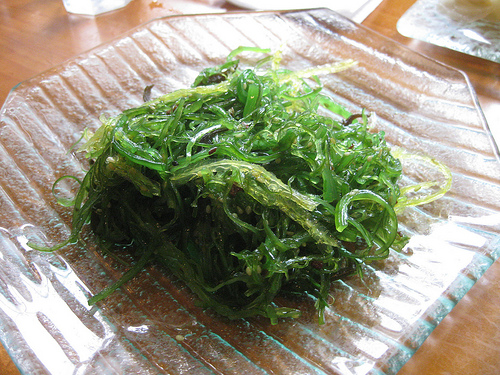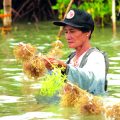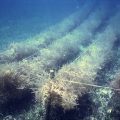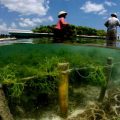New products from seaweeds were developed by the Marine Bio-Organic Group of the University of the Philippines Marine Science Institute. Three of products are now being patented, while other seaweed-based food, fertilizer and personal-use products are now ready for commercialization.

1. Seaweed-based air freshener gel (Seamoy). This is a low-cost air freshener with a gel-like texture. It makes use of sweet floral scents that give a clean, fresh smell to rooms, cars, lockers’ and cabinets.
Whole seaweeds are used in its manufacture (instead of polysaccharide extracts) making production cost low. Since the base allows a slow release of the essence, shelf life is prolonged. Unlike crystal air fresheners in the market, Seamoy can easily be divided into desired shapes and sizes for easier packing and use.
2. Fruit-flavored candy-gels (fruity cubes). These are jelly candies that are gummy-textured and come in different colors. Their flavors can be enjoyed by people of all ages. These are easy to manufacture and production cost is low. The polysaccharide used enhances the gummy texture better than gelatin.
3. Pastilles (Euginto). These are made from polysaccharides derived from seaweeds and local throat soothing substances. The manufacturing process is simple. The gummy texture is similar to that of imported pastilles. The materials used are locally available and the production cost is low.
4. Menthol ointment (Ginhawa). This is a non-greasy, soothing ointment that uses polysaccharides as a base for substances, such as menthol and camphor.
The polysaccharides used can replace the greater percentage of the usual compounds used as ointment bases. Thus, the formulation not only reduces the adverse effects between recipients, it also reduces possible allergic reactions of the user to the compounds. Production cost is similarly low.
5. Seaweed-based fertilizer (Algro). These are fertilizers that use the by-products of seaweeds processing. These fertilizers contain growth-promoting hormones and are fortified with nitrogen (N), phosphorous (P) and potassium (K) needed by plants.
The production process involves the use of pre-treatment wastes in agar/carrageenan production (or the slightly basic extract of old or enzyme-degraded brown seaweeds); waste that would otherwise be discarded. Water soluble, these fertilizers use only natural components that do not harm the soil.
6. Suppository base. This is a modification of the common suppository base formulations. It uses natural products, with carrageenan as the emulsifier and binder in place of gelatin. Once molded, it requires little refrigeration to retain its shape. It does not easily melt even at room temperature. Melting time at body temperature is comparable to that of gelatin suppositories.
7. Skinless longganisa (Longsarap/Carraniza). This is a high-fiber native sausage that contains refined and semi-refined carrageenan as a fat substitute. It allows the substitution of vegetable protein for an equal amount of pork meat. The product reduces the consumer’s calorie intake and it is highly recommended for people on a low-fat diet.
8. High-fiber pandesal (Pan de lusog/Pan de Carr). This pandesal contains refined and semi-refined carrageenans that has a higher fiber content and longer shelf-life than ordinary pandesal. Its high fiber content is an aid to diabetic who wants to maintain a blood glucose level.
9. Liquid soap/shampoo (Halimuyak/Humot). This is a shampoo base prepared from biodegradable substances and seaweed polysaccharides. The seaweed polysaccharides as a viscosity enhancer that gives better body to the finished product.
By reducing the use of synthetic soap bases and using seaweeds instead, production cost is reduced. In addition, seaweed use poses no danger to the environment when disposed while providing the user with the usual cleansing effect of ordinary soap. The new products from seaweeds are the result of the transformation of research into useful, potentially profitable goods and commodities.
Source: da.gov.ph






We are interested to know about ‘technology for value addition to sea weeds’
How to proceed for your esteemed guidance please ?